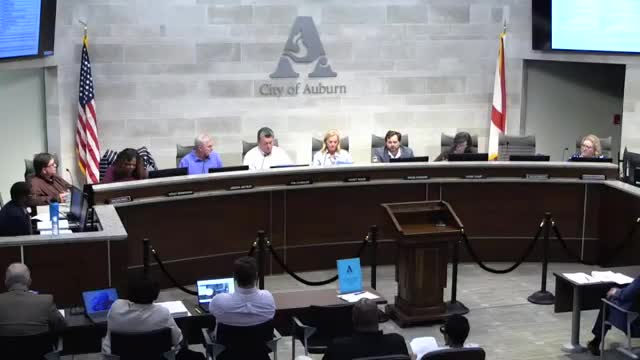Major development proposal sparks community concerns over traffic and noise
September 12, 2024 | Auburn, Lee County, Alabama
This article was created by AI summarizing key points discussed. AI makes mistakes, so for full details and context, please refer to the video of the full meeting. Please report any errors so we can fix them. Report an error »

In a recent government meeting, officials discussed a series of requests related to a proposed development site in Auburn, which includes the annexation of approximately 3.8 acres into the city limits. The property, located at the southeast corner of East Farmville Road and adjacent to US Highway 280, is currently outside city limits and would receive a rural designation upon annexation. The staff recommended approval of the annexation, which was unanimously supported by the commissioners.
Following the annexation, a request to rezone the newly annexed property from rural to Development District Housing (DDH) was presented. This rezoning aligns with the base zoning of adjacent properties and is intended to facilitate future development. The majority of the site is designated for Gateway Commercial use, although a portion is marked for limited low-density residential, which will not be developed for housing or commercial purposes. The commissioners approved the rezoning request after a brief public hearing, during which concerns about traffic and noise from potential commercial developments were raised by local residents.
The meeting also addressed a request to apply a Planned Development District (PDD) overlay to approximately 14.17 acres of the site, which includes the newly annexed property and adjacent land already zoned DDH. This overlay would allow for a master development plan that includes 80 residential units—68 townhomes and 12 multifamily units—while maintaining compatibility with the Gateway Commercial designation. The proposal includes a request for a 10% increase in density, which would allow for the development of the proposed units. In exchange, the applicant has committed to establishing a 20-foot vegetative buffer around the entire property to mitigate potential impacts on neighboring areas.
The commissioners expressed support for the PDD overlay, with conditions regarding the vegetative buffer and open space requirements. The meeting concluded with a consensus on the importance of balancing development with community concerns, ensuring that future growth aligns with the city's planning objectives.
Following the annexation, a request to rezone the newly annexed property from rural to Development District Housing (DDH) was presented. This rezoning aligns with the base zoning of adjacent properties and is intended to facilitate future development. The majority of the site is designated for Gateway Commercial use, although a portion is marked for limited low-density residential, which will not be developed for housing or commercial purposes. The commissioners approved the rezoning request after a brief public hearing, during which concerns about traffic and noise from potential commercial developments were raised by local residents.
The meeting also addressed a request to apply a Planned Development District (PDD) overlay to approximately 14.17 acres of the site, which includes the newly annexed property and adjacent land already zoned DDH. This overlay would allow for a master development plan that includes 80 residential units—68 townhomes and 12 multifamily units—while maintaining compatibility with the Gateway Commercial designation. The proposal includes a request for a 10% increase in density, which would allow for the development of the proposed units. In exchange, the applicant has committed to establishing a 20-foot vegetative buffer around the entire property to mitigate potential impacts on neighboring areas.
The commissioners expressed support for the PDD overlay, with conditions regarding the vegetative buffer and open space requirements. The meeting concluded with a consensus on the importance of balancing development with community concerns, ensuring that future growth aligns with the city's planning objectives.
View full meeting
This article is based on a recent meeting—watch the full video and explore the complete transcript for deeper insights into the discussion.
View full meeting
